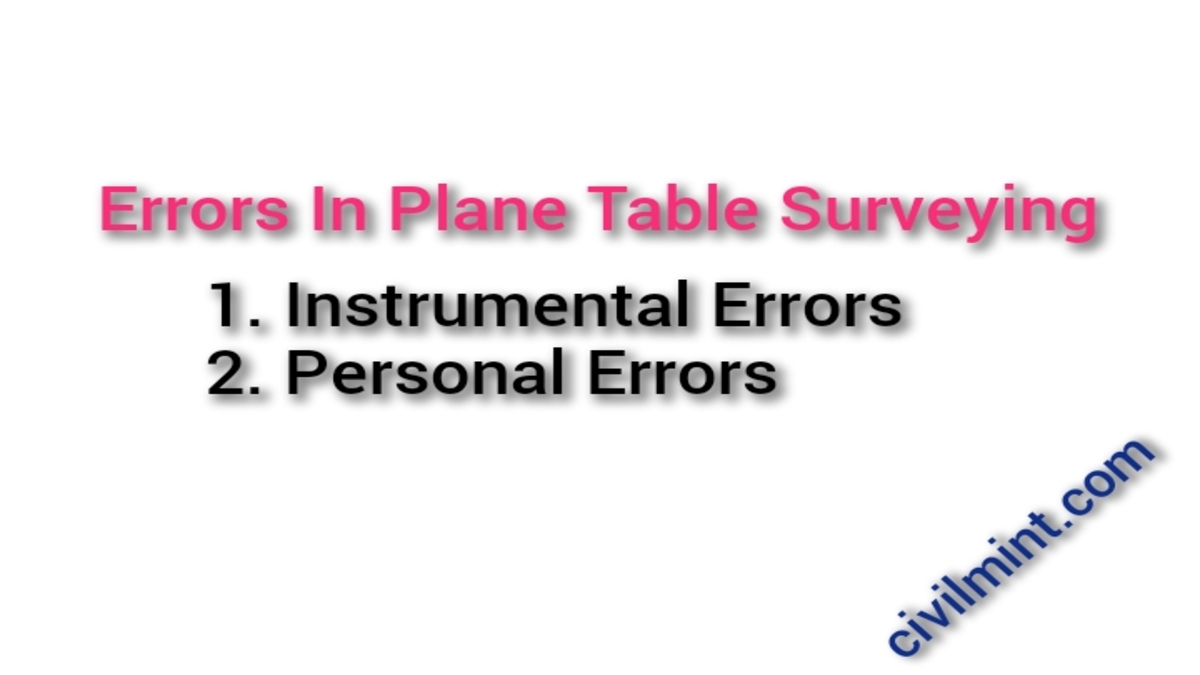Errors in plane table surveying can be caused by the equipment or the person using it. In this article I will discuss the instrumental and personal errors in plane table surveying.

Table of Contents
1. Instrumental Errors
- The surface of plane table not perfectly plane.
- Bevelled edge of alidade not straight.
- Sight vanes of alidade not perfectly perpendicular to the base.
- Plane table clamp being loose.
- Magnetic compass being sluggish.
- Drawing sheet being of poor quality.
Let’s learn these instrumental errors in detail.
(a) The surface of plane table not perfectly plane:
A plane table is an instrument used in surveying to make a topographic map of an area. It consists of a flat surface mounted on a tripod, which is used to draw the map. If the surface of the plane table is not perfectly flat, it can cause errors in the measurements and affect the accuracy of the map.
(b) Bevelled edge of alidade not straight:
An alidade is a tool used in surveying to measure angles and directions. It has a bevelled edge that is used to align the alidade with a target point. If the bevelled edge is not straight, it can cause errors in the measurement of angles and directions, which can affect the accuracy of the survey.
(c) Sight vanes of alidade not perfectly perpendicular to the base:
The sight vanes of an alidade are used to align the alidade with a target point. If the sight vanes are not perfectly perpendicular to the base of the alidade, it can cause errors in the measurement of angles and directions, which can affect the accuracy of the survey.
(d) Plane table clamp being loose:
The plane table clamp is used to hold the drawing sheet in place on the plane table. If the clamp is loose, the sheet can move around during the survey, causing errors in the measurements and affecting the accuracy of the map.
(e) Magnetic compass being sluggish:
A magnetic compass is used to determine the direction of magnetic north. If the compass is sluggish, it may not respond quickly or accurately to changes in direction, which can affect the accuracy of the survey.
(f) Drawing sheet being of poor quality:
The drawing sheet is the surface on which the map is drawn. If the quality of the sheet is poor, it can affect the accuracy of the map. Poor quality paper may tear or wrinkle easily, making it difficult to draw straight lines and accurate measurements. It may also absorb ink or other drawing materials unevenly, causing distortions in the map.
2. Personal Errors
- Centering errors
- Levelling errors
- Orientation errors
- Sighting errors
- Errors in measurement
- Plotting errors
- Errors due to instability of tripod.
Let’s learn these personal errors in detail.
(a) Centering errors:
These errors occur when the instrument used for surveying is not placed exactly at the center of the survey point. This can happen due to the lack of precision in marking the center or due to incorrect placement of the instrument.
(b) Levelling errors:
These errors occur when the instrument used for surveying is not levelled correctly. This can happen due to uneven ground, incorrect adjustments of the instrument, or the use of a faulty instrument.
(c) Orientation errors:
These errors occur when the orientation of the instrument used for surveying is not correct. This can happen due to the incorrect placement of the instrument or due to the lack of precision in marking the orientation point.
(d) Sighting errors:
These errors occur when the person sighting through the instrument does not aim at the correct point. This can happen due to human error, lack of experience, or due to the instrument being misaligned.
(e) Errors in measurement:
These errors occur due to inaccuracies in the measurement process. This can happen due to a variety of reasons such as incorrect calibration of the instrument, atmospheric conditions, or improper handling of the instrument.
(f) Plotting errors:
These errors occur during the process of plotting the survey data onto a map or plan. This can happen due to errors in recording the data, incorrect interpretation of the data, or human error.
(g) Errors due to instability of tripod:
These errors occur when the tripod used for supporting the surveying instrument is not stable. This can happen due to uneven ground, incorrect adjustment of the tripod legs, or due to a faulty tripod.
Closing Words
It is very important to avoid both instrumental and personal errors. If errors are not corrected, the survey data will be incorrect which may lead to incorrect performance.
If you have any question, please hit the comment box.
Thanks for reading my article.
